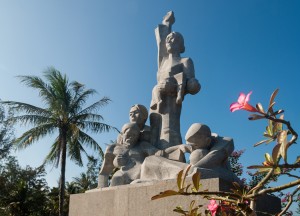My Lai Massacre 50
Friday, March 16th, 2018March 16, 2018
On March 16, 1968, 50 years ago today, the My Lai Massacre took place in the South Vietnamese hamlet of My Lai 4, commonly known as My Lai, in Sơn Mỹ village, Quảng Ngãi Province. At the height of the Vietnam War (1957-1975), United States Army troops entered the small community of My Lai 4 in search of enemy forces. In past weeks, there had been many U.S. casualties in the area. The troops found mostly women, children, and elderly men in My Lai. The soldiers rounded up and then shot and killed hundreds of civilians. The atrocity was one of the darker moments of U.S. history, and its revelation in 1969 helped turn U.S. public opinion strongly against the war.

This memorial to the victims of the My Lai Massacre was built on the site of the killings in 1978. Credit: © Dinosmichail/Shutterstock
In 1968, My Lai sat in South Vietnam near the border of North Vietnam (centrally located in today’s unified Vietnam). The area was a center of Viet Cong (South Vietnamese guerrillas fighting for the North) activity against U.S. and South Vietnamese troops. On March 15, Charlie Company of the 1st Battalion, 20th Infantry Regiment, 11th Infantry Brigade, 23rd Infantry Division, was told that My Lai 4 was part of a Viet Cong stronghold. Charlie Company had arrived in Vietnam three months previously, and had seen off-and-on fighting during the Tet Offensive that began in late January. Daily losses hardened the soldiers and traumatized some. Many sought revenge for comrades killed or wounded in action.
Upon entering My Lai on the morning of March 16, two platoons of Charlie Company (about 80 men) engaged a few enemy soldiers, but most people they encountered were civilians. Caught up in a moment of collective violence, the soldiers began killing people, accusing them of being Viet Cong sympathizers. A third platoon from Charlie Company joined in the carnage and set fire to homes and buildings. From the air, helicopter pilot Warrant Officer Hugh Thompson witnessed the killing, and—trying to stop it—reported it to his superiors. He then landed his helicopter next to a group of civilians to protect them against further slaughter. Several other soldiers refused to take part in the massacre, but by the end of the day between 350 and 500 Vietnamese, almost all of them civilians, were dead.
Warrant Officer Thompson filed a complaint about the events at My Lai, but it was silenced by his superiors. A year later, helicopter gunner Ron Ridenhour (who was not present at the massacre, but collected eyewitness testimonies) wrote about the killings to prominent people in Washington, D.C., and an official investigation was begun. In November 1969, stories detailing the My Lai Massacre appeared in U.S. newspapers, and in December, brutal photographs taken during the killings were shown on television.
Twenty-five soldiers were charged with crimes, but only Lieutenant William L. Calley, leader of Charlie Company’s 1st Platoon, was found guilty of murder. In 1971, he was sentenced to life in prison. Some people felt that Calley was unfairly singled out. They argued that Vietnam combat was so stressful that cruelty was inevitable. Calley’s sentence was repeatedly reduced, and he was released in 1974. The My Lai action caused Americans’ support for the war effort to drop, at a time when support was already low. American combat troops left Vietnam in 1973.


